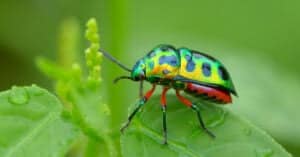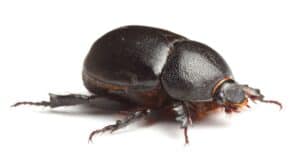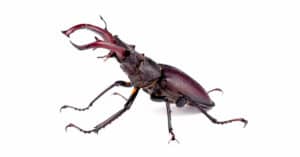Beetles are an incredibly diverse group of animals. Belonging to the order of Coleoptera, there are over 350,000 distinct species of beetles the world over. There are nearly 30,000 unique beetle species in the United States alone. While many larger species exist throughout the Earth’s warm tropics, the largest beetle in North America resides in the United States and ranks among the largest in the world.
In this article, we’ll take a look at some of the largest species of beetles in the United States. We’ll talk about how big they get, where they live, and what makes each one unique. We’ll also talk about how they reproduce and why populations of one species are in critical decline.
Eastern Hercules Beetle (Dynastes tityus)
Not only is the Hercules beetle (Dynastes tityus) the largest in the United States, but it is also one of the country’s largest insects in general. Aptly named after the Greek giant of lore, Tityos, this gargantuan beetle can reach an overall length of 7 inches!
These beetles appear throughout the eastern half of the United States. Their range extends from Florida and Texas northward into Illinois and New York. The coloration of these beetles can vary, but their bodies are normally brownish-black, black, brown, or green. The spotted elytra, which are the hard forewings that protect the delicate flight wings underneath, are usually glossy, light greenish-brown, tan, or light beige ochre.
Males and females of the species are sexually dimorphic, with males possessing a pair of long, robust, horns, and females missing them entirely. Some of the largest males possess horns that makeup over half their total body length. All species belonging to this beetle’s taxonomic subfamily, Dynastinae, possess horns and share the common name “rhinoceros beetle.
Male Hercules beetles use their impressive horns to assert dominance and fight over potential mating partners. After a pair of beetles mates, the female burrows underground and deposits many eggs in the surrounding environment. When the eggs hatch, they give way to c-shaped grubs that become rather large — around 2 inches in length. They feed on decaying wood, dead leaves, and rotten fruit for several months until they pupate in the summer. The adult beetles mature underground throughout the winter, emerging in the spring.

The eastern Hercules beetle is the largest in the United States. Males of the species use their strong horns to compete for mates and prime mating locations.
©Gerry Bishop/Shutterstock.com
Giant Stag Beetle (Lucanus elaphus)
The giant stag beetle (Lucanus elaphus) easily ranks on the list of the largest beetles in the United States. Though it falls behind the eastern Hercules beetle by a wide margin in terms of overall length, it is nonetheless an impressive species. This species appears across the east coast of the United States. It has a range that begins in Georgia and the Carolinas and continues throughout the Northeast.
Male stag beetles are instantly recognizable by the distinct, elaborate mandibles for which the species earned its scientific name elaphus — derived from the Greek word for deer. These robust mandibles emerge from the face of the beetle just like a rack of antlers from the head of a buck. And like a buck, this beetle uses its elaborate horns for mating display and territorial defense.
In early summer, males will battle each other to compete for mates and defend ideal mating territory. Once a female has mated with the victor, she deposits her fertilized eggs into the cracks and hollows of nearby rotting wood. Later in the season, the larvae emerge and consume the decaying plant matter for one to several years, eventually pupating for another several months. Once they emerge in the late spring and early summer, they spend their short lifespan of up to three months feeding on plant juices, tree sap, and rotting fruit and seed.
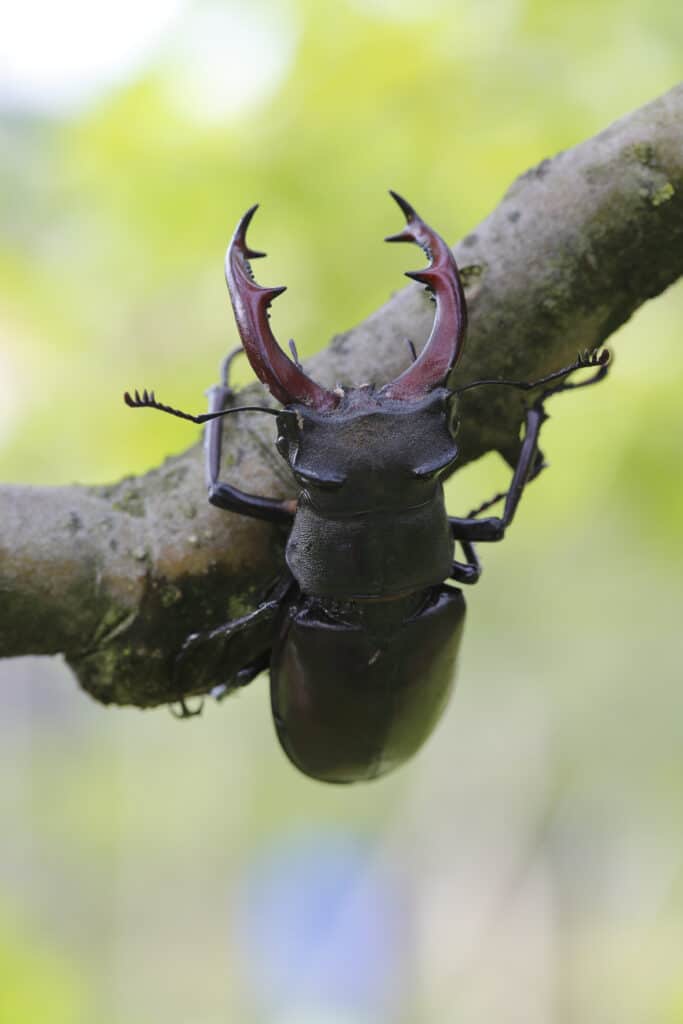
The giant stag beetle takes a close second to the Hercules beetle in terms of size. Males of the species can cap out at over 2 ½ inches in length when their elaborate mandibles are included in the measurement!
©iStock.com/Lukasok
Horned Passalus (Odontotaenius disjunctus)
There are over 500 species of beetles that belong to the family Passalidae. However, only a couple of them occur in North America. One of them, the horned passalus (Odontotaenius disjunctus), goes by many names. Known colloquially as the bess beetle, betsy beetle, peg beetle, strong boy, or horn beetle, it is the most frequent member of its family to occur on the continent.
This beetle occurs throughout the eastern portion of the United States, inhabiting most places from eastern Texas to Florida, parts of the Midwest, and northward into the Great Lakes area. They are large for North American beetles, ranging in size from 1 ¼ to 1 ⅝ inches in length. This species has a pronotum with a single, deep, central groove and a pair of elytra that are deeply grooved in their entirety. The horned passalus also produces golden-yellow hairs that cover the margins of its middle pair of legs, pronotum, and antennae. Between the eyes of both sexes of beetle protrudes a small, curved horn, earning this species its accepted common name. First, a glossy red as they exit their pupal stage, the bess beetle’s carapace darkens to a deep black at maturity.
If you’re looking to find one of these beetles, it’s usually pretty easy. They are common throughout their range in just about any location with plentiful rotting hardwood. Adults will compete over mating sites in decaying wood, subsequently mating and depositing clutches of eggs within its fibers. Interestingly, the horned passalus exhibits subsocial, cooperative behavior when it comes to caring for newly hatched larvae. Multiple generations of beetles will live in the same log, caring for their young until they become fully mature and take flight from the gallery to start a new reproductive group.
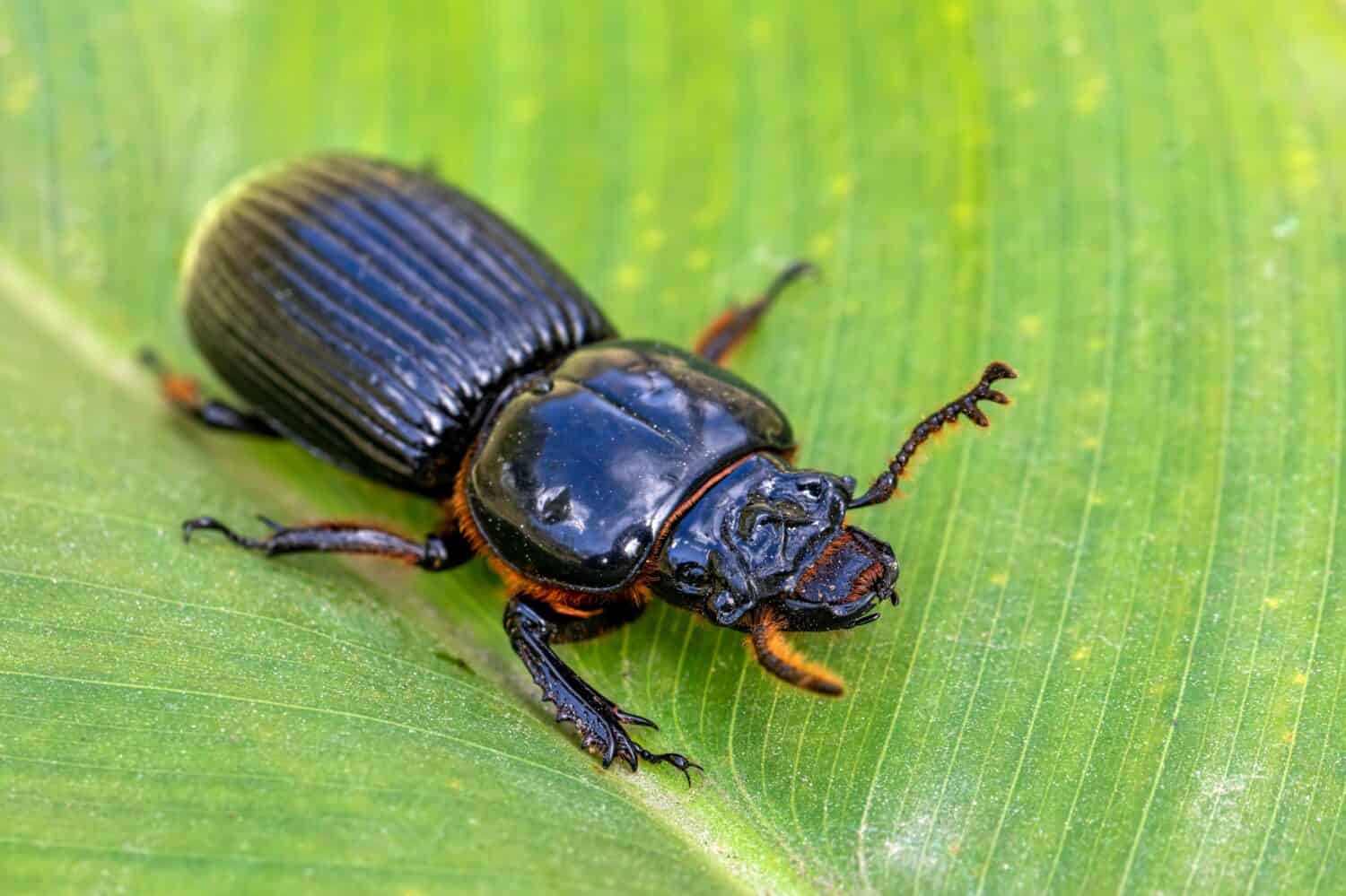
The horned passalus, colloquially known as the bess beetle, peg beetle, or strong boy, spends much of its life cycle inside decaying trees and logs. They leave their host log only when they mature, taking a flight to mate and begin a new subsocial group.
©Artush/Shutterstock.com
Giant Carrion Beetle (Nicrophorus americanus)
Also known as the American burying beetle, this beautiful insect derives its common name from its carrion-collecting behavior. They hide during the day. Then, these insects use their strong wings to fly out in search of carrion food during the nighttime hours.
These days, members of this species are hard to find, appearing on the IUCN’s list of critically endangered species. While their range once spanned the vast majority of the temperate, eastern portion of the continent, sizeable populations now occur in only two locations in Oklahoma and Rhode Island. Small populations may exist in other locales, but they are likely limited in range. Researchers attribute their decline to several factors. Loss and fragmentation of habitat, increase in predator populations, and competition for decaying carcasses are all likely contributors.
Competition with other animals for carcasses affects the beetle in multiple ways. Not only does it decrease the availability of food overall, but it also restricts their ability to reproduce. Mating pairs of this species require a small carcass the size of a chipmunk, dove, or pigeon to produce healthy offspring. The carcass size is critical, as much smaller animals don’t usually provide enough food for the developing larvae.
During the summer, groups of adult beetles compete for a suitable carcass. Whichever pair emerges victorious will bury it, either in place or in a nearby location. If the pair decides to move the carcass, which is usually hundreds of times their weight, they move it in a novel way. Lying on their backs, they balance the corpse above them on their feet and pass it forward to each other in the style of a conveyor belt. Considering that these insects are only about an inch or so in length, the fact that they can move such a heavy object up to a meter away is quite impressive.
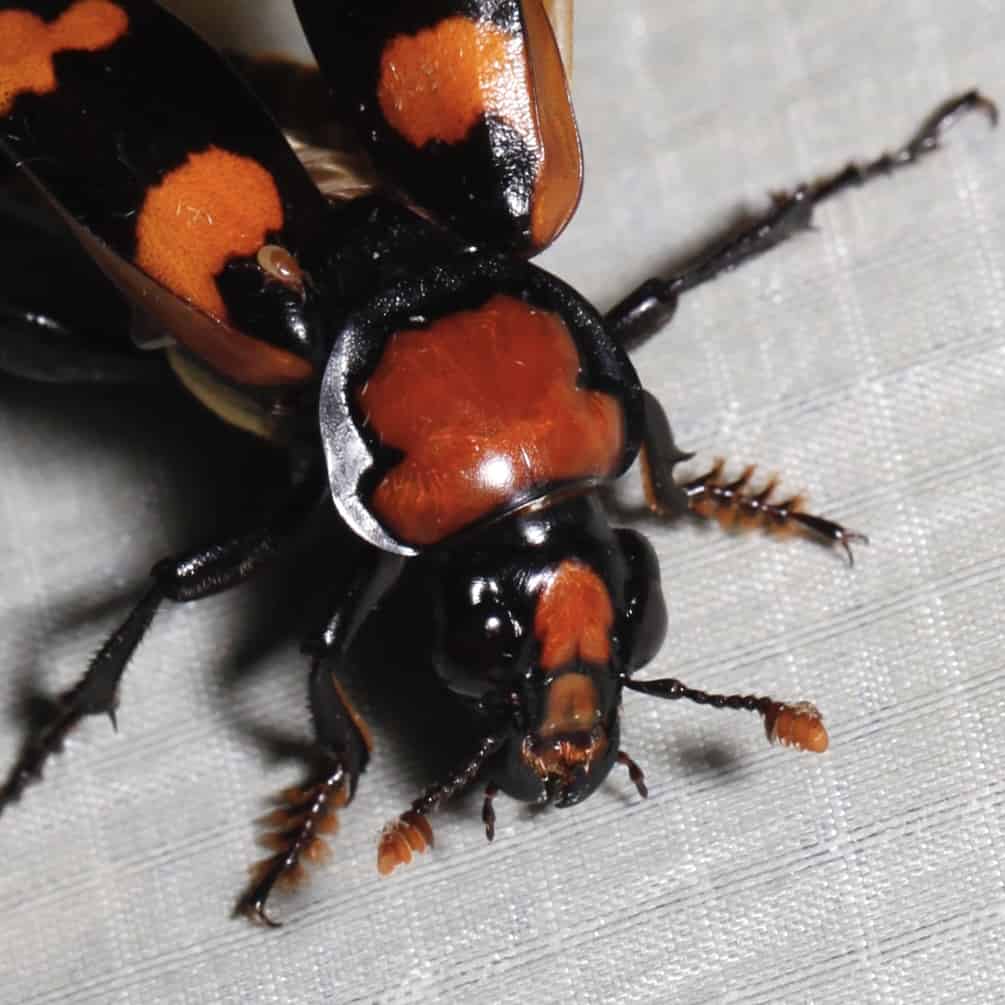
A male American burying beetle lifting its elytra to take flight. These beautiful
carrion beetles
are listed as critically endangered by the IUCN.
The photo featured at the top of this post is © Galumphing Galah/Shutterstock.com
Thank you for reading! Have some feedback for us? Contact the AZ Animals editorial team.




